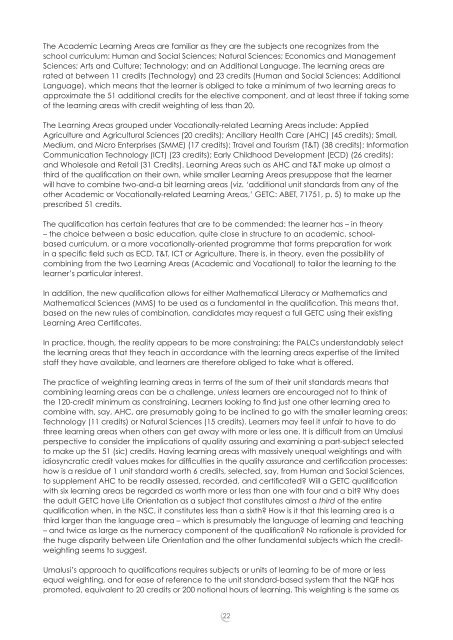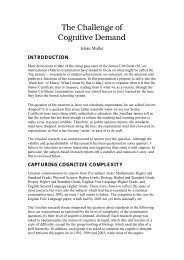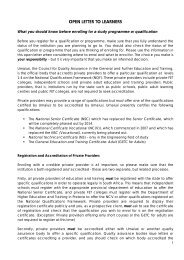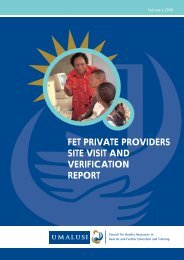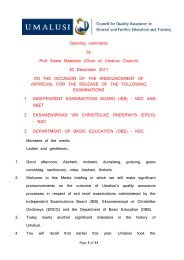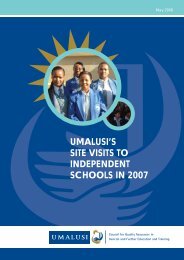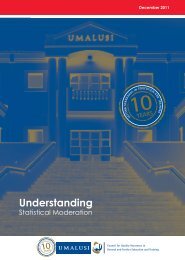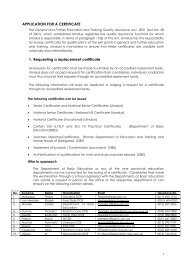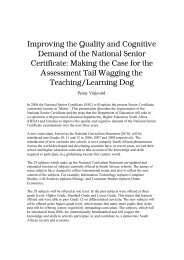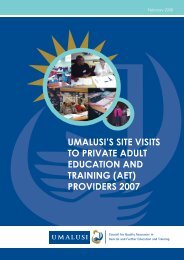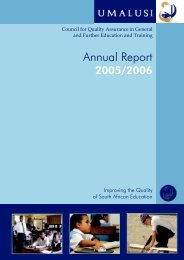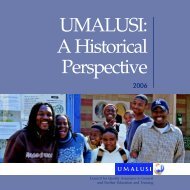Inspecting the Foundations - Umalusi
Inspecting the Foundations - Umalusi
Inspecting the Foundations - Umalusi
Create successful ePaper yourself
Turn your PDF publications into a flip-book with our unique Google optimized e-Paper software.
The Academic Learning Areas are familiar as <strong>the</strong>y are <strong>the</strong> subjects one recognizes from <strong>the</strong>school curriculum: Human and Social Sciences; Natural Sciences; Economics and ManagementSciences; Arts and Culture; Technology; and an Additional Language. The learning areas arerated at between 11 credits (Technology) and 23 credits (Human and Social Sciences; AdditionalLanguage), which means that <strong>the</strong> learner is obliged to take a minimum of two learning areas toapproximate <strong>the</strong> 51 additional credits for <strong>the</strong> elective component, and at least three if taking someof <strong>the</strong> learning areas with credit weighting of less than 20.The Learning Areas grouped under Vocationally-related Learning Areas include: AppliedAgriculture and Agricultural Sciences (20 credits); Ancillary Health Care (AHC) (45 credits); Small,Medium, and Micro Enterprises (SMME) (17 credits); Travel and Tourism (T&T) (38 credits); InformationCommunication Technology (ICT) (23 credits); Early Childhood Development (ECD) (26 credits);and Wholesale and Retail (31 Credits). Learning Areas such as AHC and T&T make up almost athird of <strong>the</strong> qualifi cation on <strong>the</strong>ir own, while smaller Learning Areas presuppose that <strong>the</strong> learnerwill have to combine two-and-a bit learning areas (viz. ‘additional unit standards from any of <strong>the</strong>o<strong>the</strong>r Academic or Vocationally-related Learning Areas,’ GETC: ABET, 71751, p. 5) to make up <strong>the</strong>prescribed 51 credits.The qualifi cation has certain features that are to be commended: <strong>the</strong> learner has – in <strong>the</strong>ory– <strong>the</strong> choice between a basic education, quite close in structure to an academic, schoolbasedcurriculum, or a more vocationally-oriented programme that forms preparation for workin a specifi c fi eld such as ECD, T&T, ICT or Agriculture. There is, in <strong>the</strong>ory, even <strong>the</strong> possibility ofcombining from <strong>the</strong> two Learning Areas (Academic and Vocational) to tailor <strong>the</strong> learning to <strong>the</strong>learner’s particular interest.In addition, <strong>the</strong> new qualifi cation allows for ei<strong>the</strong>r Ma<strong>the</strong>matical Literacy or Ma<strong>the</strong>matics andMa<strong>the</strong>matical Sciences (MMS) to be used as a fundamental in <strong>the</strong> qualifi cation. This means that,based on <strong>the</strong> new rules of combination, candidates may request a full GETC using <strong>the</strong>ir existingLearning Area Certifi cates.In practice, though, <strong>the</strong> reality appears to be more constraining: <strong>the</strong> PALCs understandably select<strong>the</strong> learning areas that <strong>the</strong>y teach in accordance with <strong>the</strong> learning areas expertise of <strong>the</strong> limitedstaff <strong>the</strong>y have available, and learners are <strong>the</strong>refore obliged to take what is offered.The practice of weighting learning areas in terms of <strong>the</strong> sum of <strong>the</strong>ir unit standards means thatcombining learning areas can be a challenge, unless learners are encouraged not to think of<strong>the</strong> 120-credit minimum as constraining. Learners looking to fi nd just one o<strong>the</strong>r learning area tocombine with, say, AHC, are presumably going to be inclined to go with <strong>the</strong> smaller learning areas:Technology (11 credits) or Natural Sciences (15 credits). Learners may feel it unfair to have to dothree learning areas when o<strong>the</strong>rs can get away with more or less one. It is diffi cult from an <strong>Umalusi</strong>perspective to consider <strong>the</strong> implications of quality assuring and examining a part-subject selectedto make up <strong>the</strong> 51 (sic) credits. Having learning areas with massively unequal weightings and withidiosyncratic credit values makes for diffi culties in <strong>the</strong> quality assurance and certifi cation processes:how is a residue of 1 unit standard worth 6 credits, selected, say, from Human and Social Sciences,to supplement AHC to be readily assessed, recorded, and certifi cated? Will a GETC qualifi cationwith six learning areas be regarded as worth more or less than one with four and a bit? Why does<strong>the</strong> adult GETC have Life Orientation as a subject that constitutes almost a third of <strong>the</strong> entirequalifi cation when, in <strong>the</strong> NSC, it constitutes less than a sixth? How is it that this learning area is athird larger than <strong>the</strong> language area – which is presumably <strong>the</strong> language of learning and teaching– and twice as large as <strong>the</strong> numeracy component of <strong>the</strong> qualifi cation? No rationale is provided for<strong>the</strong> huge disparity between Life Orientation and <strong>the</strong> o<strong>the</strong>r fundamental subjects which <strong>the</strong> creditweightingseems to suggest.<strong>Umalusi</strong>’s approach to qualifi cations requires subjects or units of learning to be of more or lessequal weighting, and for ease of reference to <strong>the</strong> unit standard-based system that <strong>the</strong> NQF haspromoted, equivalent to 20 credits or 200 notional hours of learning. This weighting is <strong>the</strong> same as22


